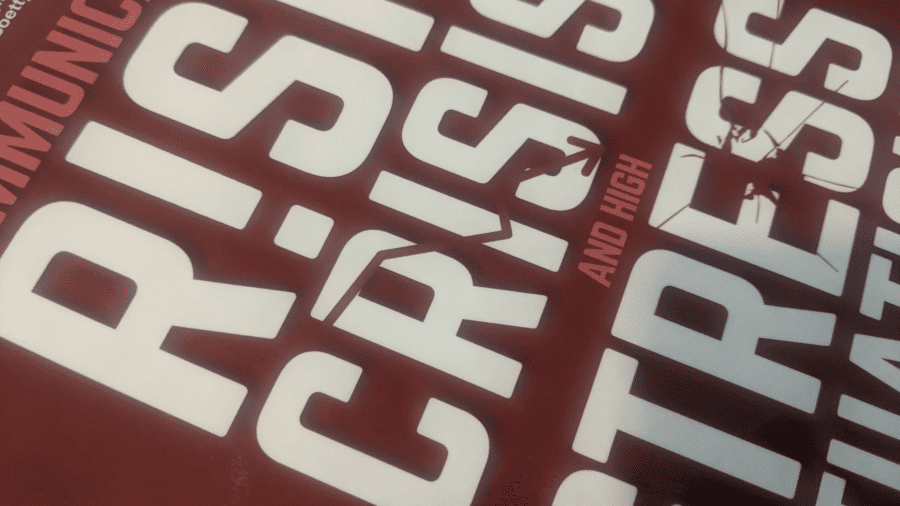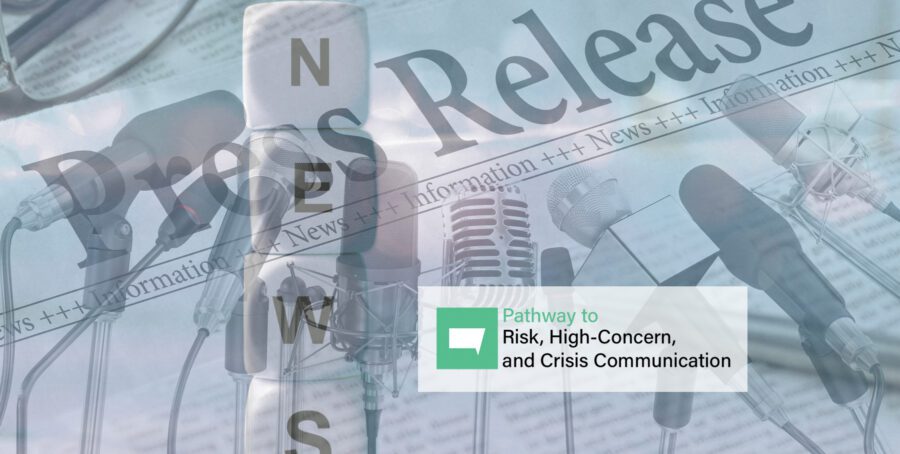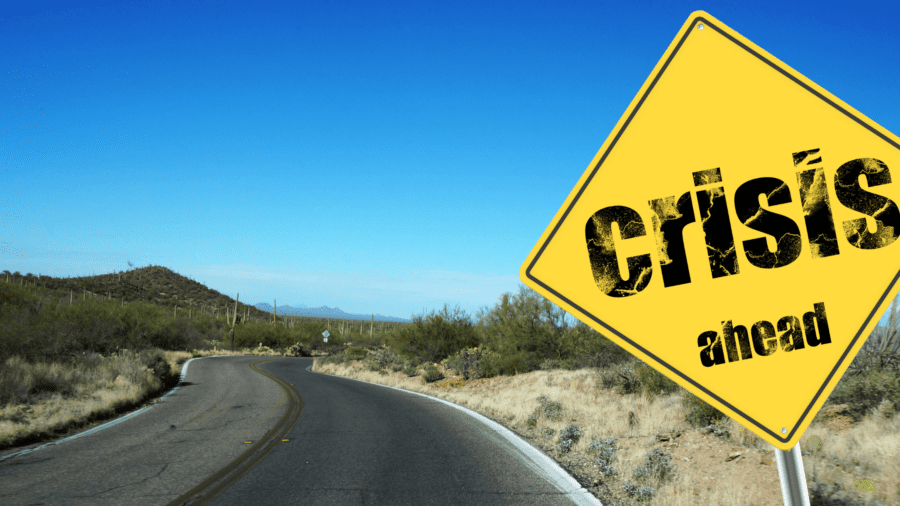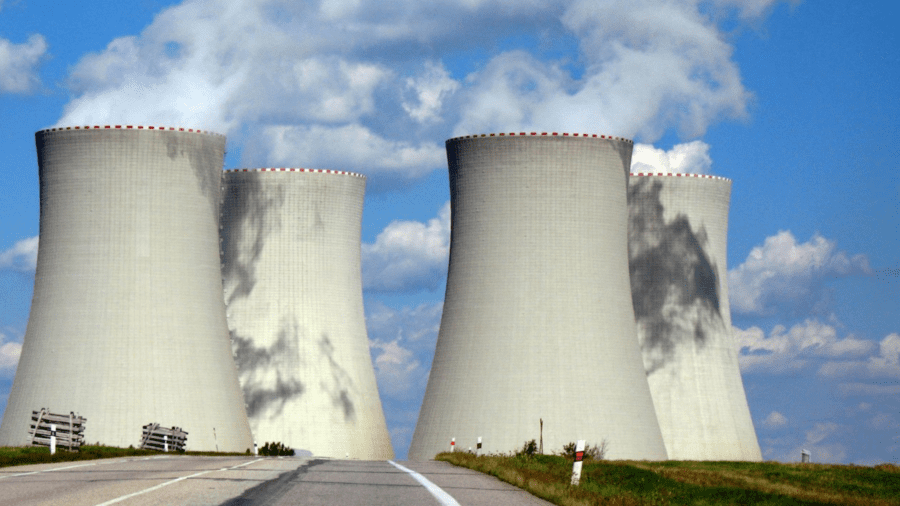Our Latest News
Pathway Blog
A Look Inside “Communicating in Risk, Crisis, and High Stress Situations” (Part 13)
Early in the COVID-19 pandemic, the World Health Organization (WHO) presented Dr. Vincent Covello with what seemed like an impossible mission: work with a band of scientists, communication professionals and…
A Look Inside “Communicating in Risk, Crisis, and High Stress Situations” (Part 12)
As a pioneer in the realm of risk, high concern and crisis communication, Dr. Vincent Covello never knows what to expect when he checks his phone. In one case, he…
A Look Inside “Communicating in Risk, Crisis, and High Stress Situations” (Part 11)
The XXXI Olympic Games in Brazil in 2016 set the stage for a risk communication challenge that extended over multiple fronts. The culprit: mosquitoes spreading the Zika virus. At the…
A Look Inside “Communicating in Risk, Crisis, and High Stress Situations” (Part 10)
Any threat to the health of children raises high concern and an unfailingly emotion-driven response. This was the case when concerned citizens believed hazardous waste from an industrial facility had…
A Look Inside “Communicating in Risk, Crisis, and High Stress Situations” (Part 9)
As we look back now, February 2020 might seem as though it were a decade ago. COVID-19 was already changing the world in complex ways. For Dr. Vincent Covello, that…
A Look Inside “Communicating in Risk, Crisis, and High Stress Situations” (Part 8)
In the summer of 2014, the director-general of the World Health Organization (WHO) appointed Dr. Vincent Covello to serve as senior adviser to a WHO emergency committee aimed at Ebola,…
A Look Inside “Communicating in Risk, Crisis, and High Stress Situations” (Part 7)
In 1989, a remarkable interview took place on CBS’s 60 Minutes. Before 40 million viewers, the acting administrator of the Environmental Protection Agency, Dr. Jack Moore, sat in the hot…
A Look Inside “Communicating in Risk, Crisis, and High Stress Situations” (Part 6)
Toxic gases were spreading after an explosion at an industrial plant in Asia. If something wasn’t done quickly, the situation would worsen drastically. The industrial plant needed aid but inexplicably…
A Look Inside “Communicating in Risk, Crisis, and High Stress Situations” (Part 5)
Boos, foot-stomping, and catcalls are not the hoped-for response when hosting a public forum. But after a town hall meeting went disastrously awry, that’s exactly the reaction Dr. Vincent Covello…
A Look Inside “Communicating in Risk, Crisis, and High Stress Situations” (Part 4)
No matter where you work, when you get a call from your organization’s director, you answer that call. In 1981, the organization in question was the National Science Foundation, the…
A Look Inside “Communicating in Risk, Crisis, and High Stress Situations” (Part 3)
A mysterious green ooze was leaking through basement cracks in scattered locations. On one side, the government’s perplexed environmental investigators. On the other, angry homeowners. The approach Dr. Vincent Covello…
A Look Inside “Communicating in Risk, Crisis, and High Stress Situations” (Part 2)
Communicating in Risk, Crisis, and High Stress Situations: Evidence-Based Strategies and Practice from Dr. Vincent T. Covello provides communicators with a comprehensive resource for addressing situations in which trust has…
A Look Inside “Communicating in Risk, Crisis, and High Stress Situations” (Part 1)
With the release of Communicating in Risk, Crisis, and High Stress Situations: Evidence-Based Strategies and Practice, Dr. Vincent T. Covello presented communicators with a comprehensive resource for addressing situations in…
Book Focus: “Communicating in Risk, Crisis, and High Stress Situations”
If the last two years have taught us anything, it’s that communicating difficult technical concepts to stressed audiences presents a major challenge. The task is made easier, though, with the…
Vincent Covello and Randall Hyer Discuss Times of Uncertainty on “Coffee with ACC President”
Practitioners of risk, high-concern, and crisis communication received a wealth of insight when Dr. Randall Hyer (VP, Global Medical Affairs, Moderna) and Dr. Vincent Covello (founder and director of the...
22 Risk Communication Lessons for 2022
A new year is upon us. With ongoing concerns about COVID-19, variants, and vaccine hesitancy, risk communication will continue to hold a prominent place in stakeholder communications. The following are…
Book Alert: Communicating in Risk, Crisis, and High Stress Situations
Risk communication professionals everywhere can head into 2022 with a comprehensive resource from world-renowned risk communicator Vincent Covello: the new release Communicating in Risk, Crisis, and High Stress Situations: Evidence-Based…
Who Needs Risk Communication?
On its most basic level, risk communication is communication that conveys information in an easy-to-understand manner so that people can make informed decisions. As such, risk communication entails tools and…
Three Facts about Nonverbal Communication in High-Concern Situations
Nonverbal communications can provide more than 75 percent of message content related to trust. Seventy-five percent. Let that sink in. When communicating in high-risk situations, it is easy to concentrate…
Public Outreach Materials and Risk Communication
Risk communicators use public outreach materials such as fact sheets and FAQs as an important resource for informing stakeholders about risk. These materials, when printed in hard copy or posted…
Risk Amplification and Public Stakeholders: What Do Risk Communicators Do When the Public and Experts Disagree?
The public does not always agree with experts about the level of risk associated with a hazard. When risk amplification occurs, public stakeholders may rate a risk as high, while…
Practical Tips for Message Development for Risk Communicators
When making decisions about risks and threats, people in high-stress situations will typically rely more on perceptions driven by emotions and instinct than on technical facts. In high-stress situations, additional…
Pathway Reads: The Speed of Trust
Trust is the single-most-important filter through which information about risks and threats passes. With this in mind, it is well worth reading The Speed of Trust: The One Thing That…
How Do You Explain Vaccine Hesitancy? (Redux)
With President Joe Biden announcing on Sept. 9, 2021, proposed vaccine mandates for as many as 100 million people, vaccine hesitancy is still very much an area of concern for…
Risk Communication Expert Launches Online Training
Dr. Covello, a nationally and internationally recognized trainer, researcher, consultant and expert in risk communication, reports to have offered the course after receiving frequent requests for widely accessible risk communication training. Located at the Pathway website (pathwaycommunication.com), the course comprises nine video lectures, nine printable course guides, and supplemental materials.
Five Key Messages for Risk Communication
In addition to communicating risk information, risk communicators often have to communicate information about the very definition of risk communication to leaders, stakeholders, teammates, and other interested parties. While this…
Unfamiliar Activities and Technologies Present Challenges for Risk Communication
Why do unfamiliar activities and technologies pose challenges for risk communication? The Pathway team presents answers.
Emotion and Scientific Certainty in Risk Communication
The Pathway team breaks down the roles emotion and scientific certainty play in risk perceptions.
Risk Communication Life Hack: Elements of an Effective Apology
In this post the Pathway team breaks down the elements of an effective apology.
What Is Crisis Communication?
The Pathway team examines the definition and goals of crisis communication.
Frequently Asked Questions after a Major Crisis
After a crisis, risk communicators face questions from both journalists and the press. The Pathway team presents some of the most common.
Tips for Crisis Communication: Best Practices for Interacting with Mainstream News Media
Interacting with mainstream news media is an important but tricky part of risk and crisis communications. The Pathway team offers quick tips for working in this realm.
Improve Your Crisis Communications Message Maps by Starting with a Question
The Pathway team suggests now is a good time to review your communications plan with risk communication in mind.
Is It Time to Update Your Crisis Communications Plan?
The Pathway team suggests now is a good time to review your communications plan with risk communication in mind.
Five Challenges for Explaining Technical Information
Communicating technical information about risks and threats isn’t easy. The Pathway team shares five of the main challenges posed by communicating this type of information.
Six Steps to Message Mapping
The Pathway team provides a high-level glimpse of the message map creation process.
What Risk Communication Is—and What It Isn’t
Here the Pathway team clears up a few misperceptions about risk communication.
Risk Communication and Magic Numbers
The numbers three and seven figure prominently in the work of risk, high-concern, and crisis communicators.
A Simple Switch Grants Your Message More Authority
When it comes to convincing leadership, research beats “I think” every time.
Show That You Care for Effective Risk Communications
Risk communicators need to show that they care before people will care what they know.
UX Honeycomb Sweetens Risk Communications
The Pathway team examines the UX honeycomb for insight into better risk communication.
What Is Meant by Risk Communication?
Risk communication is embraced by the world’s top health organizations. Learn how they define the practice.
Not in My Backyard! NIMBY, LULU and Risk Communication
Before addressing community concerns about chemical, nuclear, and other industrial facilities, it is important to understand possible sources of anger.
How Can Teams Use the Principles of Risk Communication to Communicate Better in a Virtual World?
Working from home poses challenges to communicating effectively with teammates. Principles of risk communication shed light on why this is so.
Three Factors That Affect Evaluations of Risk
A wide range of factors affect how people grade risk. Read on for three of the most prevalent.
9 from 9: Nine Lessons on Risk, High-Concern, and Crisis Communication from a Master Practitioner
World-renowned risk communicator Dr. Vincent Covello offers nine lessons fpr communicating in times of stress and high concern.
The Effects of High Stress on the Brain
The brain functions differently during times of high stress. Risk communicators can use this information to communicate more effectively.
Why Does the Media Have Trouble Communicating Risk Information?
The media often struggles to adequately convey risk information. Here’s why.
9 Reasons People Hoarded Toilet Paper
The hoarding of toilet paper during the COVID-19 pandemic provides a lesson for risk-communication professionals.
How Do You Explain Vaccine Hesitancy? Part 3
In part three of this look at vaccine hesitancy, the Pathway team examines the vaccine-specific factors for vaccine hesitancy and the characteristics of successful vaccine efforts and campaigns.
How Do You Explain Vaccine Hesitancy? Part 2
In the second part of this three-part series on vaccine hesitancy, the Pathway team looks at group and individual factors.
How Do You Explain Vaccine Hesitancy? Part 1
The rollout of vaccines for COVID-19 has resulted in a division between those eager to get the vaccine and those experiencing some level of hesitancy. But what accounts for this vaccine hesitancy?
Using Science to Communicate in a Virtual World
Scientific concerns affect communication during the new reality of working from home.
Five Tips for Using Plain Language during Risk Communication
Plain language ensures an audience understands what you’re saying or writing as quickly and as easily as possible.Plain language increases readership by making the language available to a wider audience. Plain language also increases accessibility for marginalized populations.
Risky Business: How Do Risk Communicators Define Risk?
Defining risk is an important first step for risk, high-concern, and crisis communicators.
Inaccurate Perceptions of Risk Have Widespread Consequences
Risk perceptions profoundly affect the risk decision-making of leaders and the ability of people to make informed decisions. In other words, people will make wildly varying decisions based on what they perceive to be the level of risk. For this reason, risk communicators are well served to understand why people overestimate (or underestimate) risks, and communicators also need to understand the consequences.
Resolutions for Risk Communicators in 2021
The Pathway team offers nine resolutions for risk, high-concern, and crisis communicators in 2021.
Cultural Diversity and Worldviews in Risk, High-Concern, and Crisis Communication
Five major types of worldviews are important to consider for risk, high-concern, and crisis communication.
Risk Communication, the Challenger Tragedy, and the Importance of Visuals
The presentation of visual information can greatly affect decision-making in high-risk situations.
A Powerful Tool for Risk, High-Concern, and Crisis Communication
The CCO template is one of the most powerful tools in the risk communicator’s tool kit.
What Factors Affect Informed Decision-Making in Risk Communication?
Perceptions of risk greatly affect decision-making.
Cultural Filter Theory in Risk, High-Concern, and Crisis Communications
Researchers turned to cultural filter theory to explain differences in responses to communications by social and cultural groups.
Four Theories at the Heart of Risk, High-Concern, and Crisis Communication
Learn the four theories at the heart of risk, high-concern, and crisis communication.
Risk, High-Concern, and Crisis Communications Go Beyond the Workplace
The principles of risk, high-concern, and crisis communications apply both in and out of the workplace.
Dr. Covello and the Center for Risk Communication
Among his many roles, Dr. Vincent Covello is the founder and director of the Center for Risk Communication.
Pathway Presents a Wealth of Learning Opportunities
In addition to the video lectures. Dr. Vincent Covello’s course on risk, high-concern, and crisis communication contains an extensive resource list for further exploration.
Challenges of Social Media in the World of Risk, High-Concern, and Crisis Communication
Social media presents a wide range of challenges for risk, high-concern, and crisis communication.
Benefits of Social Media in the World of Risk, High-Concern, and Crisis Communication
Benefits arise from the use of social media in the realm of risk, high-concern, and crisis communication.
Research Base Powers Risk, High-Concern, and Crisis Communication
An extensive body of research lies behind the principles of risk, high-concern, and crisis communication.
Cultural Factors Affect Risk Communication
Risk, high-concern, and crisis communicators must always consider culture when communicating.
Mental Noise Blocks Communication—and What You Can Do About It
Mental noise presents challenges for communication.
The Brain Uses Mental Shortcuts to Judge Risks and Threats
Everyone loves a shortcut. Even your brain. Shortcuts play a big role in risk communication because the human brain uses mental shortcuts to calculate the probability of adverse outcomes.
How Do You Get Your Audience to Focus on the Positive?
Sometimes there’s no way around delivering bad news to your audience. No matter how much you’d like to avoid it, the news might be information your customers need to do their jobs or it might be health news that your community needs to protect themselves and others.
Are Nonverbal Cues Subverting Your Communications?
As the old saying goes, it’s not what you say but how you say it. This is especially true in the world of risk, high-concern, and crisis communication. In a classic and widely cited set of studies on nonverbal communication, Albert Mehrabian found the following…


Throughline, Inc.
1838 Columbia Road, NW
Washington D.C., 20009































































